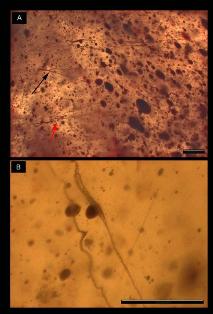
Scientists have confirmed that threads found within amber deposits from the Sussex coast are the world’s oldest known spider webs, dating back to 140 million years ago, writes Sarah Day.
Geoscientist Online, October 31 2009
The amber was found by amateur fossil hunters whilst looking for dinosaur remains, and has since been studied by University of Oxford palaeontologist Professor Martin Brasier. The conclusions of the research are to be published in the latest issue of the Journal of the Geological Society.
‘This amber is very rare’, says Brasier. ‘It comes from the very base of the Cretaceous, which makes it one of the oldest ambers anywhere to have inclusions in it’.
As well as threads of spider webs, the amber contains plant matter, insect droppings and ancient microbes that were trapped during the early Cretaceous Period, a time when the world was a much warmer place, and dinosaurs such as the Iguanodon and the Allosaurus were in their prime.
Scientists have also found the earliest evidence of Actinobacteria – a tiny group of organisms that break down wood and resins into soil particles, potentially rewriting the history of soil evolution.
Since the discovery of the amber, analysis of the threads has shown that they were spun by spiders closely related to modern day orb-web, or garden spiders.
‘These spiders are distinctive and leave little sticky droplets along the spider web threads to trap prey’ says Brasier. ‘We actually have the sticky droplets preserved within the amber. These turn out to be the earliest webs that have ever been incorporated in the fossil record to our knowledge’.
The webs became trapped in resin emitted by trees, probably as a response to fire damage. The amber was then deposited in a large lake bed, until it was exposed by uplift and erosion along the shoreline. Taphonomic experiments using modern cherry trees have demonstrated that very similar threads can be obtained by trapping modern spider webs in resin.
Only a tiny proportion of the deposits have so far been examined, and Brasier believes they have the potential to yield many more exciting finds, largely due to the development of increasingly powerful imaging techniques.
‘It’s a very exciting time to be a palaeontologist, because of all these wonderful techniques being developed. We’re able to view things and see detail in ways that we’ve never been able to before’.
To reconstruct the webs, the scientists focused through the amber at 40 different positions, tracing it through the layers and then splicing it together again using a computer technique called confocal microscopy.
As well as the amber, there are several other types of deposit at the site which are showing remarkable levels of preservation, including silica and phosphate minerals.
'It’s part of a larger project which is yielding rich rewards. There’s still a lot more to find, and we have even more exciting things to report in the near future’.
- Journal reference: Journal of the Geological Society, London, Vol. 166, 2009, pp. 1-9
These findings have been published in the media, a selection of which are available to view below: